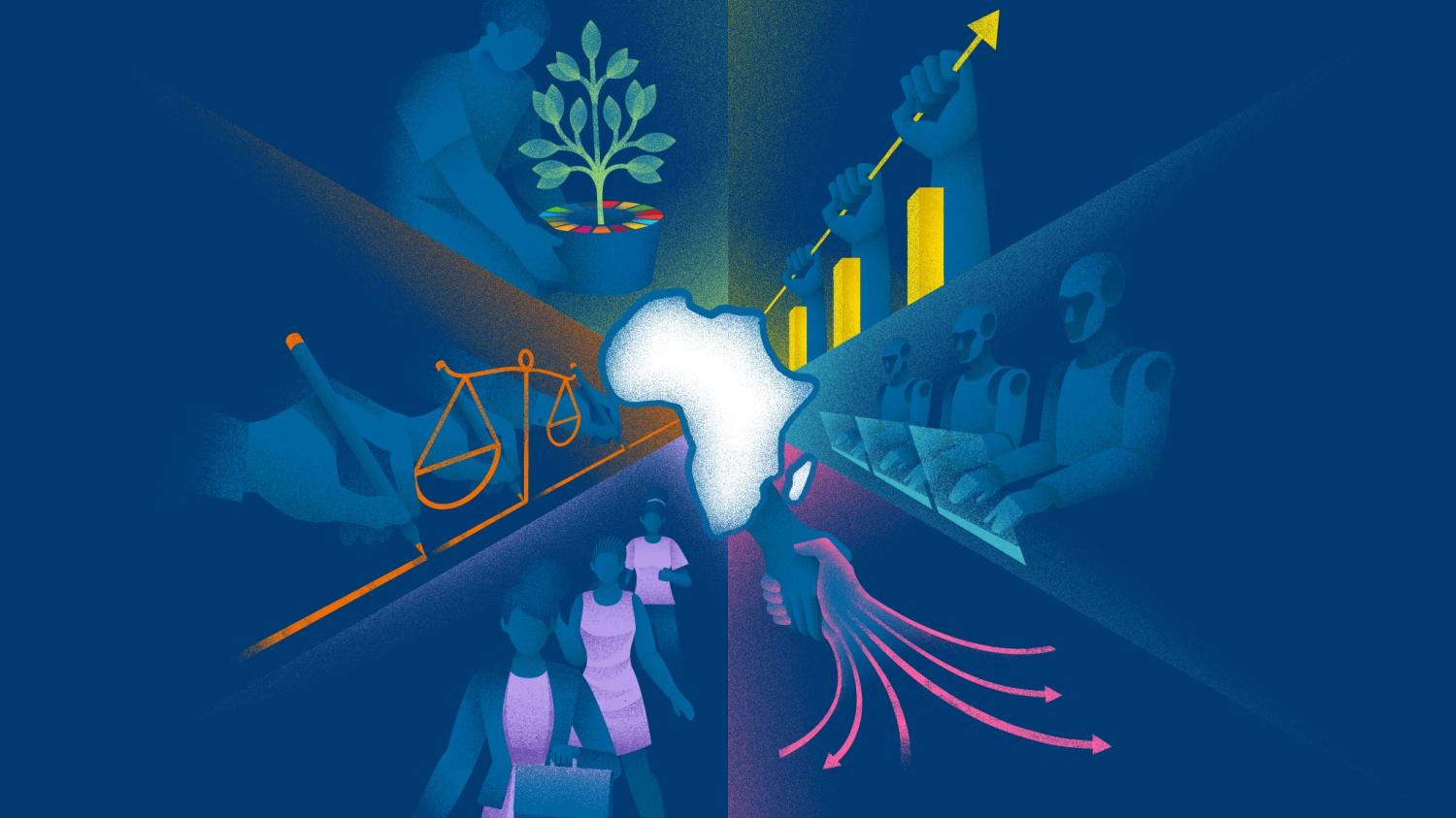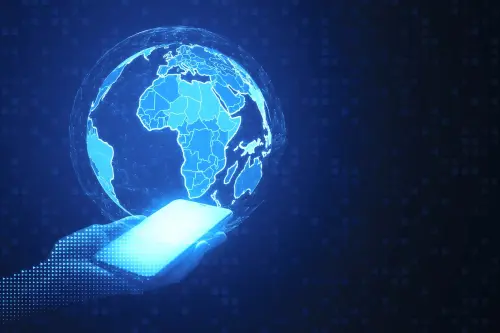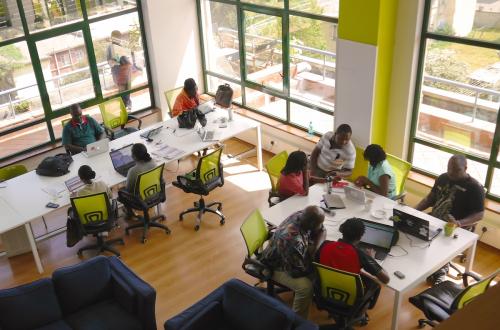This viewpoint is part of Chapter 5 of Foresight Africa 2025-2030, a report with cutting-edge insights and actionable strategies for Africa’s inclusive and sustainable development in the run-up to 2030. Read the full chapter on AI and emerging technologies.
Several examples of AI applications in agriculture illustrate how AI is already making a tangible impact on agriculture in Africa, improving efficiency, productivity, and sustainability.
Africa’s agricultural sector faces compounding pressures, with climate change, degraded soil, and rapid population growth straining its ability to provide sufficient food. Today, 282 million Africans go hungry every day, a situation projected to worsen as climate-related challenges intensify.1 By 2030, nearly 118 million people in Africa could face droughts, floods, and extreme temperatures, further heightening food insecurity and underscoring the urgent need for agricultural innovation.2
In many sectors, technology and innovation drive development, yet agriculture remains one of the least digitized sectors. This lack of digital integration limits smallholder farmers’ capacity to respond effectively to changing environmental and market conditions. Attempts have been made to remedy this; the African Union established a Digital Transformation Strategy which included provisions for improving the efficiency and effectiveness of the African agricultural system to make it more resilient to climate change and environmentally sustainable by 2030.3 The strategy seeks to contribute to the Comprehensive African Agricultural Development Program’s vision of eliminating hunger and reducing poverty by raising economic growth through agriculture-led development and promoting increased national budget provision to the agriculture sector.4
The Fourth Industrial Revolution (4IR) also has the potential to transform Africa’s agricultural sector, supporting the continent’s progress toward the 2030 Sustainable Development Goals (SDGs) by enhancing food security, resilience, and sustainability.5 Technologies such as artificial intelligence (AI), blockchain, and the Internet of Things are beginning to address age-old challenges in agriculture such as low productivity and market inefficiencies in the face of climate change.6 Through data-driven insights and automated tools, digital innovation enables improved decisionmaking, precision targeting, and resource efficiency, which are essential to bolstering Africa’s agricultural productivity and ensuring food security for its growing population.7
The impact of 4IR technologies on African agriculture is evident, with CGIAR playing a pivotal role in this transformation.8 CGIAR has been leading the use of 4IR tools to address agricultural challenges, introducing innovations such as digital soil mapping and AI-powered crop disease detection systems. These technologies have enabled farmers to identify and treat diseases early, resulting in higher yields and reduced crop loss. For example, IITA’s Cassava Disease Surveillance platform in Nigeria,9 the Cassava Seed Tracker,1010 and the Plant Village Nuru AI app help smallholders diagnose and manage cassava diseases rapidly,11 resulting in higher yields and minimized losses.
Several examples of AI applications in agriculture illustrate how AI is already making a tangible impact on agriculture in Africa, improving efficiency, productivity, and sustainability. Hello Tractor, often referred to as the “Uber for farmers,”12 uses AI to connect tractor owners with farmers in need of plowing services, enhancing access to farm machinery and boosting productivity. PlantVillage leverages AI to help farmers detect plant diseases early, significantly improving agricultural resilience.13 The Malawi Digital Plant Health Service is a countrywide initiative for coordinating internationally developed digital systems.14 It bundles complementary digital tools developed across the world such as PlantVillage (Penn State University, U.S.), VIPS (NIBO, Norway),15 FIA (IITA, Benin), and Prise and PlantWise (CABI, U.K.) to support smallholder farmers in pest and disease management.16
Additionally, AI technologies are used in precision agriculture for soil monitoring, including soil fertility and overfertilization, as well as for automated irrigation and pest, disease, and weed prediction. Ujuzi Kilimo builds sensors and farm data analytics tools to collect, analyze, and make sense of agricultural data for the world’s smallholder farmers.17 The Project FARM platform uses AI to determine farming patterns through big data, generating insights from the data to make recommendations and using machine learning to scale the platform by connecting it with cellphones.18
CGIAR has also developed precision agriculture tools such as smart irrigation and climate forecasting, optimizing water usage and helping farmers prepare for adverse weather patterns. Digital agronomy tools like RiceAdvice and NextGen Agroadvisory provide locationspecific fertilizer and planting recommendations, resulting in 25% yield increases for wheat and rice and improved profitability for smallholder farmers in Ethiopia, Nigeria, and Mali.19 CGIAR has been extensively using big data and cutting-edge digital technologies in research for development to accelerate the generation of nutritious, climate-resilient, high-yield crop varieties that are suitable for diverse market segments and end-user profiles through modern breeding methods and genome editing technologies.20 Remote sensing technologies and AI are being used for mapping crops using satellite for disease surveillance,21 AI mobile apps for disease detection, and information and communication technologies for disease management in farmers’ fields.22 These tools help smallholder farmers optimize input use and improve profitability.
In West Africa and the Sahel, a consortium of stakeholders has established a regional hub for fertilizer and soil health to help improve soil health status in the region, enhance soil fertility, and promote sustainable land management practices using digital soil mapping and other 4IR technologies.23 Additionally, CGIAR has enhanced market access through digital platforms and blockchain systems, enabling transparent supply chains, reducing the influence of middlemen, and allowing farmers to connect directly with buyers. These advancements lower input costs and improve profit margins, making agriculture more sustainable and attractive for smallholder farmers across the continent. A good example is the Technologies for African Agricultural Transformation,24 launched by the African Development Bank and implemented by CGIAR,25 which has already delivered climate-smart seeds to 12 million farmers in 27 countries in just three years. The Technologies for African Agricultural Transformation program has been using digital tools to promote validated technologies through an e-catalogue which allows stakeholders to select appropriate technologies for adoption.26
Despite these successes, challenges persist in the adoption of 4IR tools due to uneven access and low digital literacy.27 The risk of job displacement due to automation, especially for low-skilled labor in rural areas, is a pressing concern, requiring investments in reskilling programs to equip workers for more technical roles.28 Furthermore, the digital divide continues to limit access to technology while limited internet connectivity, particularly in rural areas, further impedes the widespread adoption of digital solutions.29 Data privacy and security issues also need to be addressed through robust governance frameworks to ensure that farmers maintain control over their data while benefiting from digital advancements.30 While fintech solutions like mobile money and digital loans have improved financial inclusion, infrastructure limitations still prevent many smallholders from fully realizing the benefits of these technologies.31
To maximize the transformative potential of 4IR in agriculture, African governments and stakeholders must prioritize enabling policies, ethical technology use, and equitable access. This involves establishing data governance policies that protect farmers’ rights, creating digital literacy programs, and fostering public-private partnerships to drive innovation. To support these goals, CGIAR, through initiatives like the Digital Transformation Accelerator Program, partners with African national programs to promote data governance frameworks that protect smallholder farmers’ data rights.32 This initiative backs policies that enhance digital literacy, data security, and equitable technology access, ensuring the full participation of smallholder farmers in the digital transformation of agriculture.
Regional and international collaboration is also crucial, as it enables knowledge sharing and the scaling of solutions tailored to Africa’s diverse agricultural contexts. Equipping young people and women with digital skills fosters entrepreneurship and creates new job opportunities, addressing social inequalities and boosting rural economies. Initiatives in this space include the GIZ Digital Transition Center program,33 which, in collaboration with the public and private sectors, research, and academia, works with several African governments to foster the digitalization of micro, small, and medium enterprises, including agribusiness, and improve the innovation ecosystem. This approach creates jobs for youth and benefits economies. Several youth-led initiatives also use digital technologies to promote entrepreneurial skills, create employment opportunities, provide loans for startups, and help create market linkages.34
Investing in 4IR infrastructure is crucial for transforming African agriculture. 4IR innovations can enhance agriculture in several ways — enhancing the productivity of seed and soil, putting food on the table, providing opportunities for marketing and financing, developing innovations, building infrastructure and networks, and informing policy-making.
With these strategies, Africa’s agricultural sector can harness 4IR technologies to address urgent food security challenges, driving sustainable development and resilience in agri-food systems across the continent.
-
Footnotes
- “Alarm Bells Ignored as Africa Continues to Face Deepening Food Crisis,” Food and Agriculture Organization of the United Nations, July 12, 2023, https://www.fao.org/newsroom/detail/alarm-bells-ignored-as-africa-continues-to-facedeepening-food-crisis/en; Emily Barone, “What Climate Change Means For Africa’s Food Crisis,” TIME, October 5, 2022, https://time.com/6220057/climate-change-africa-food-crisis/.
- “Africa Faces Disproportionate Burden from Climate Change and Adaptation Costs,” World Meteorological Association, September 2, 2024, https://wmo.int/news/media-centre/africa-faces-disproportionate-burden-from-climate-changeand-adaptation-costs.
- “The Digital Transformation Strategy for Africa (2020-2030)” (African Union, n.d.), https://au.int/sites/default/files/documents/38507-doc-dts-english.pdf.
- “Comprehensive Africa Agricultural Development Programme,” CAADP, accessed December 16, 2024, https://caadp.org/.
- Francie Sadeski et al., “Potential of the Fourth Industrial Revolution in Africa” (Abidjan: African Development Bank Group; Korea-Africa Economic Cooperation, October 2019), https://www.technopolis-group.com/wp-content/uploads/2020/02/Potential-of-the-fourth-industrial-revolution-in-Africa.pdf.
- 6 Rambod Abiri et al., “Application of Digital Technologies for Ensuring Agricultural Productivity,” Heliyon 9, no. 12 (December 1, 2023): e22601, https://doi.org/10.1016/j.heliyon.2023.e22601.
- “Fertile Ground for Digitalisation: Adopting Digital Technologies to Improve Farming and Food Security in Africa,” AUDA-NEPAD (blog), July 19, 2023, https://www.nepad.org/blog/fertile-ground-digitalisation-adopting-digitaltechnologies-improve-farming-and-food-security.
- “CGIAR: Science for Humanity’s Greatest Challenges,” CGIAR, accessed December 16, 2024, https://www.cgiar.org/.
- “IITA and NAQS Pilot Digital Cassava Disease Surveillance Platform,” IITA (blog), accessed December 16, 2024, http://www.iita.org/news-item/iita-naqs-pilot-digital-cassava-disease-surveillance-platform/.
- “Cassava Seed Tracker,” accessed December 16, 2024, https://seedtracker.org/cassava/.
- James Legg, “Nuru Mobile Phone App is Being Scaled out to Help Farmers in sub-Saharan Africa Identify and Manage Cassava Diseases,” MEL, April 20, 2020, https://mel.cgiar.org/projects/-15/210/nuru-mobile-phone-app-is-beingscaled-out-to-help-farmers-in-sub-saharan-africa-identify-and-manage-cassava-diseases.
- romainsame, “AI and Sustainable Agriculture in Africa: Utopia or Imminent Reality?,” Africa Hub, November 8, 2023, https://www.aiafricahub.org/en/blog-en/social-environmental-impact/ai-sustainable-agriculture-africa/.
- “PlantVillage Nuru: Pest and Disease Monitoring Using AI,” CGIAR Platform for Big Data in Agriculture, accessed December 16, 2024, https://bigdata.cgiar.org/digital-intervention/plantvillage-nuru-pest-and-disease-monitoring-using-ai/.
- “About Malawi Digital Plant Health Service (MaDiPHS),” MaDiPHS, accessed December 16, 2024, https://madiphs.org/malawi-digital-plant-health-service-madiphs/.
- “VIPS – Nibio,” Nibio, accessed December 16, 2024, https://www.nibio.no/en/services/vips.
- “PRISE: A Pest Risk Information Service,” CABI (blog), accessed December 16, 2024, https://www.cabi.org/projects/prise-a-pest-risk-information-service/; “Plantwise: Helping Farmers Loses Less and Feed More,” CABI (blog), accessed December 16, 2024, https://www.cabi.org/projects/plantwise/.
- “Ujuzi Kilimo,” accessed December 16, 2024, https://www.ujuzikilimo.com/.
- Laura Foster et al., “Smart Farming and Artificial Intelligence in East Africa: Addressing Indigeneity, Plants, and Gender,” Smart Agricultural Technology 3 (February 1, 2023): 100132, https://doi.org/10.1016/j.atech.2022.100132; “Project FARM – An Intelligent Data Platform to Resolve Global Food Shortages,” Capgemini (blog), December 6, 2019, https://www.capgemini.com/news/client-stories/project-farm-an-intelligent-data-platform-to-resolve-globalfood-shortages/; “Ujuzi Kilimo.”
- “AfricaRice | RiceAdvice,” AfricaRice, accessed December 16, 2024, https://www.africarice.org/riceadvice; “Smallholder Farmers in Ethiopia Utilizing NextGen Agro-Climate Advisory Increased Wheat Yield by 25%,” CGIAR (blog), 2022, https://www.cgiar.org/initiative-result/smallholder-farmers-in-ethiopia-utilizing-nextgen-agro-climate-advisoryincreased-wheat-yield-by-25/.
- “Reflections on Workshop: Adaptive Co-Design of Research for Development (R4D) Evaluations – the Need for Engagement, Learning and Ongoing Reflection,” May 19, 2023, https://iaes.cgiar.org/evaluation/news/reflectionsworkshop-adaptive-co-design-research-development-r4d-evaluations-need; “New Project Aims to Modernize Rice Breeding in Africa,” Excellenceinbreeding, accessed December 16, 2024, https://excellenceinbreeding.org/news/new-project-aims-modernize-rice-breeding-africa; Leena Tripathi et al., “Genome Editing for Sustainable Agriculture in Africa,” Frontiers in Genome Editing 4 (May 12, 2022), https://doi.org/10.3389/fgeed.2022.876697.
- “Africa: Remote-Sensing Models to Combat Banana Bunchy Top Virus,” Global Plant Protection News, January 17, 2023, https://iapps2010.wordpress.com/2023/01/16/africa-remote-sensing-models-to-combat-banana-bunchy-top-virus/.
- “Combating Banana Disease through Digital Innovation,” ICT4BXW, accessed December 16, 2024, https://www.ict4bxw.com/; Mariette McCampbell et al., “Are Farmers Ready to Use Phone-Based Digital Tools for Agronomic Advice? Ex-Ante User Readiness Assessment Using the Case of Rwandan Banana Farmers,” The Journal of Agricultural Education and Extension 29, no. 1 (January 1, 2023): 29–51, https://doi.org/10.1080/1389224X.2021.1984955.
- Evans Samuel, “New Partnership to Deliver Improved Farm Productivity from Soil Health and Fertility,” IITA (blog), accessed December 16, 2024, http://www.iita.org/news-item/new-partnership-to-deliver-improved-farm-productivityfrom-soil-health-and-fertility/.
- “Global Partnerships and Investments, Crucial to Leveraging Technologies for Food Systems Transformation – AfDB, CGIAR and Stakeholders,” Taat Africa, June 3, 2024, https://taat-africa.org/news/global-partnerships-and-investmentscrucial-to-leveraging-technologies-for-food-systems-transformation-afdb-cgiar-and-stakeholders/.
- “African Development Bank Group,” African Development Bank Group, accessed December 16, 2024, https://www.afdb.org/en.
- “TAAT Africa E-Catalogs,” Taat Africa, accessed December 16, 2024, https://e-catalogs.taat-africa.org.
- Rik Moors, “Reimagining TVET for 4IR Jobs in Africa,” ACET (blog), August 14, 2023, https://acetforafrica.org/researchand-analysis/insights-ideas/articles/reimagining-tvet-for-4ir-jobs-in-africa/.
- Holzer, “Understanding the Impact of Automation on Workers, Jobs, and Wages,” Brookings Institution (blog), January 19, 2022, https://www.brookings.edu/articles/understanding-the-impact-of-automation-on-workers-jobs-and-wages/.
- “Widening Digital Gap between Developed, Developing States Threatening to Exclude World’s Poorest from Next Industrial Revolution, Speakers Tell Second Committee,” United Nations, October 6, 2023, https://press.un.org/en/2023/gaef3587.doc.htm.
- Jasmin Kaur et al., “Protecting Farmers’ Data Privacy and Confidentiality: Recommendations and Considerations,” Frontiers in Sustainable Food Systems 6 (October 19, 2022), https://doi.org/10.3389/fsufs.2022.903230.
- Ellis L. C. Osabutey and Terence Jackson, “Mobile Money and Financial Inclusion in Africa: Emerging Themes, Challenges and Policy Implications,” Technological Forecasting and Social Change 202 (May 1, 2024): 123339, https://doi.org/10.1016/j.techfore.2024.123339.
- “Digital Transformation Accelerator: Full Design Document” (CGIAR, November 15, 2024), https://cgspace.cgiar.org/items/aed44adf-59b3-4e18-87c8-5f6271af9e88; “Digital Transformation,” CIGAR Accelerator on Digital Transformation, accessed December 16, 2024.
- “Digital Transformation Center Nigeria,” DTC Nigeria, accessed December 16, 2024, https://dtcnigeria.ng/.
- “I-Youth Project – Agribusiness Trainings | Gender Inclusion | Decent Employment | Youth Inclusion | Agric-Clubs | Mindset Change,” I-Youth, accessed December 16, 2024, https://iyouth.iita.org/.
The Brookings Institution is committed to quality, independence, and impact.
We are supported by a diverse array of funders. In line with our values and policies, each Brookings publication represents the sole views of its author(s).







Commentary
Digital solutions in agriculture drive meaningful livelihood improvements for African smallholder farmers
May 20, 2025